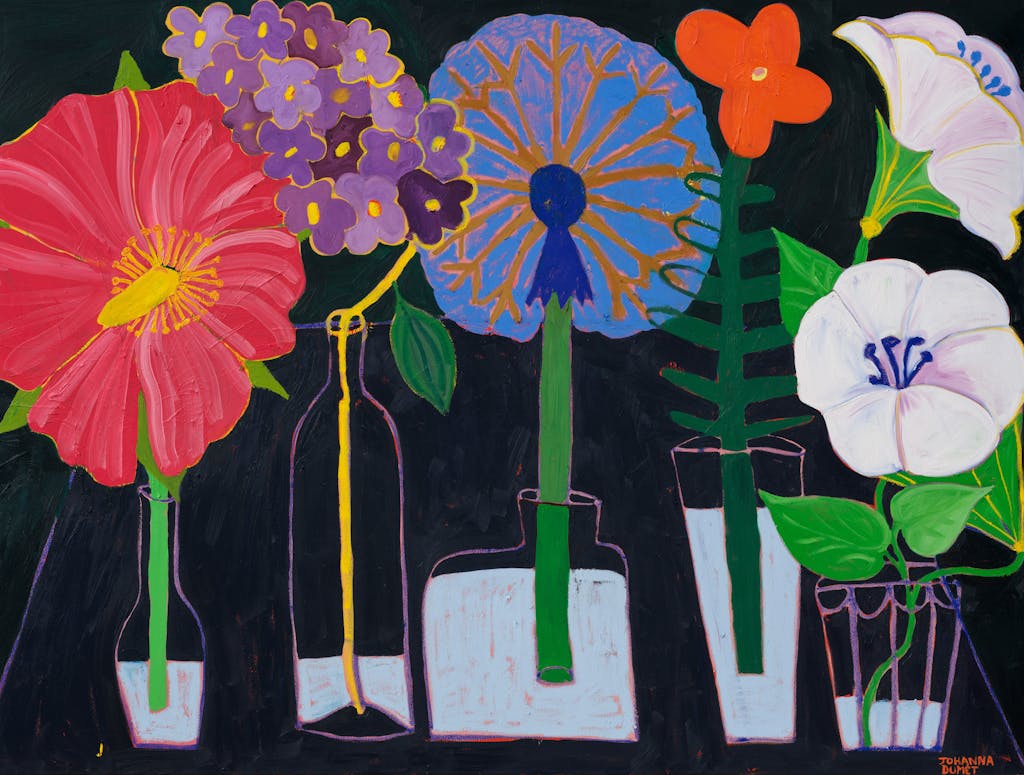Her still lifes, which often accompany these space-related paintings, depict flowers, fruit and vegetables as well as randomly picturesque objects or arranged meals. While such compositions may recall the immediacy of social media, Dumet aims to lend her motifs a supra-temporality through a painterly engagement with the old genre using traditional techniques. When she turns to still life, she does so with a determined eye for the simplicity and everyday relevance of late French depictions of the 18th century, far from any courtly ostentation. With her lively paintings, she resists what the French term ‘nature morte’ suggests in her mother tongue – inanimate objects, ‘dead nature’.
Through her painting, the artist says, the objects take on ‘personality’. This idea is underscored by the strong, vivid colours and the vigour that emanates from them. They represent a decidedly contemporary approach for Dumet, reminiscent of Henri Matisse (1869–1954) in their saturated appearance. Like Matisse and other Fauvist painters, Dumet eschews pictorial depth, revealing an attempt to create a poetic space solely through the presence of colour.
The fundamental idea of visualising vanitas and reformulating it for relevance today extends across traditional subjects such as flowers, food, and utilitarian objects, but also goes beyond them. Dumet captures ephemeral consumer goods like women's shoes or handbags on her canvases, transcending the fashion season. Their transience, an essential feature of many fashion accessories, is preserved in her art.
Dumet's restaurant paintings represent a remarkable series of works. On a table seen from above, dishes and food are not festively set, but rather we see the table after the meal, with visible vestiges. This snapshot, reminiscent of the sculptural works of Swiss artist Daniel Spoerri (b. 1930), is depicted by Dumet through painting and collage. More than just the leftovers, Dumet's depiction captures the situation in which the idea for the picture was born: a meal with friends, connected with memories of cherished people, a beautiful evening and good conversations. She later sticks the restaurant bill onto the picture, the only non-painterly object in these works. Here, Dumet dares to play with capitalism, as the bill will ultimately be settled by the patron who buys the work.
For the artist, extending her painting as an opening to space is tantamount to a window, an opening ‘into another world’. Her play of concealing and revealing is demonstrated in her three-dimensional works by the possibility of opening and closing her paintings, which she conceives as triptychs with hinges, reminiscent of an altarpiece. However, the views are of cupboards as they stand against or hang on walls. Once opened, they reveal their contents: crockery, food, household objects. For Dumet, the view into the painted cupboards is simultaneously a view into an extérieur. In other paintings, she depicts intérieurs, still views of space that captivate the eye, convey moods and challenge the imagination. Here too, through painterly means and with an eye to art history in form and theme, Dumet evokes a timeless vibrancy.
Johanna Dumet was born in Guéret, France, in 1991. She started painting at an early age, but first studied arts and crafts in La Souterraine, near her birthplace, and then fashion design in Marseille before returning to painting. In 2024, she took up a residency with Manuel Wroblewski at the CCA Andratx, Mallorca. Dumet's work is represented in numerous private and public collections, including the Buxton Contemporary Art Museum, Melbourne, Australia; the Hall Art Foundation, Derneburg, Germany; the Kistefos Museum, Jevnaker, Norway; and the art collection of the German Bundestag. Johanna Dumet lives in Berlin.
